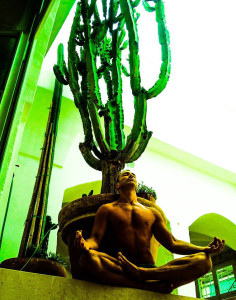Yoga (my personal definition)
Defining yoga is an hard task especially because, to paraphrase the master Pattabhi Jois, is a discipline made up of a 90% practice and only 10% theory, and as far as some only write and read about it, they will never gain access to its enormous wealth if they don’t actually try it first.
In common stereotypes you can find a multi-faceted picture that goes from sitting and reciting “strange chants” to a relaxing experience maybe created exclusively for women and possibly not challenging enough for the body.
Others see it as a form of religion, or worse, a sort of cult or maybe an elite discipline for which you have to be extremely flexible in order to practice real circus contortions.
All these generalizations arise mainly because of the infinite versatility of what is an ancient discipline that has “navigated” from East to West with all its transformations and interpretations.
A form of ART that, although it has historically been part (and still is) of some religious traditions, is actually unlinked to any creed and therefore available to ALL. A discipline and not a sport or simple physical exercise, but something deeper that totally differs from the other activities it is often compared to.
It has laid the foundation for many of the current physical practices , but being often extrapolated devoid of its deeper aspects like in the case, for example, of the technique of “stretching” so frequently used in preparation for sports.
In fact with Yoga the main point to be addressed is not “what we do” but “how we do it.”
Rooted in ancient philosophies but with some very practical implications, it can be considered a system for the harmonious development of body, mind and spirit of human beings.
The very meaning of the word Yoga is literally “union” and is derived from the Sanskrit word “yuj,” bind: the commitment to merge and reconcile the various aspects of life and ultimately its opposites. Mind and body, stillness and movement, masculine and feminine, sun and moon and so on.
By practicing yoga, we aspire to this harmonization of elements to achieve a sense of inner peace and well-being. The body is the instrument with which to observe and learn about the mind while the breath is the bridge between the mental and the physical, the link that communicates with both without ever lying.
It is the breath itself to be the focal point of the practice: it is the one and only controlling all the movements and it is therefore consciously felt, as the source of a process and not its result.
By breathing correctly we can channel energy or Prana that sustains all movements and allows to maintain positions for longer even if challenging, and through stretching, bending, lengthening, twisting and so on we can harmoniously bring balance in all body systems, organs and internal glands.
Paradoxically, during the practice we use the body to understand that we are not the body, or rather, only the body, and to transcend it demonstrating that the form and correctness of execution are secondary compared to the journey itself, to our commitment, to how we feel and what occurs in our mind while we hold the positions.
An experience mostly invisible where we can confront ourselves with our own conscience as we are the only ones capable to sense our inner world, although a good teacher can somehow grasp it.
Our presence and concentration, our awareness and attention are the parameters for the lesson to take on a totally different meaning and become a sort of revolution.
Where we learn the art of self-observation free from any judgment, where we gain self-knowledge and control the EGO in order to be able to create that healthy detachment from RESULTS.
This is at the core of a renewed inner peace typical only of those who no longer have to prove anything to themselves and the others. Definitely a foreign concept in a society based on competition and the need to assert itself through achievements more or less material.
The practice of Yoga is recommended for everyone, from the housewife to the athlete, from the pregnant woman to the child as long as we are committed to find our congenial style other than the teacher in “resonance” with us .
With it we can tone up the body and make it more supple, we can improve the function of all internal organs and eliminate many kinds of joint pain and stiffness, reduce anxiety, insomnia, depression, fatigue, weakness, panic attacks and all kinds of psychosomatic problems while enhancing general mental health.
At the end of each lesson a sense of inner peace, strength, self-confidence, contentment, and joy of living are the feelings that normally are reported by all students .The benefits do not stop in the classroom, but continue off the mat in every day’s life and not after months of practice but from the first weeks, always increasing thanks to continuous commitment.
As well described by David B. Hughes:
“Yoga is like music, mathematics, art or any other great tradition: you get from it what you put into it. If better health and a smaller waistline are all you want from Yoga, the class across town will do just fine. And if you want to plumb the depths of consciousness, understand the purpose of the universe, mitigate all material pain, attain spiritual bliss through self-realization and have a personal rendezvous with God, you can get all that from Yoga too. But to cross that great ocean, you must prepare for a longer and more arduous voyage, perhaps decades in length. Arm yourself with good maps and plenty of supplies. And please: don’t try to redesign the ship. It was wrought by much better hands than ours.”

